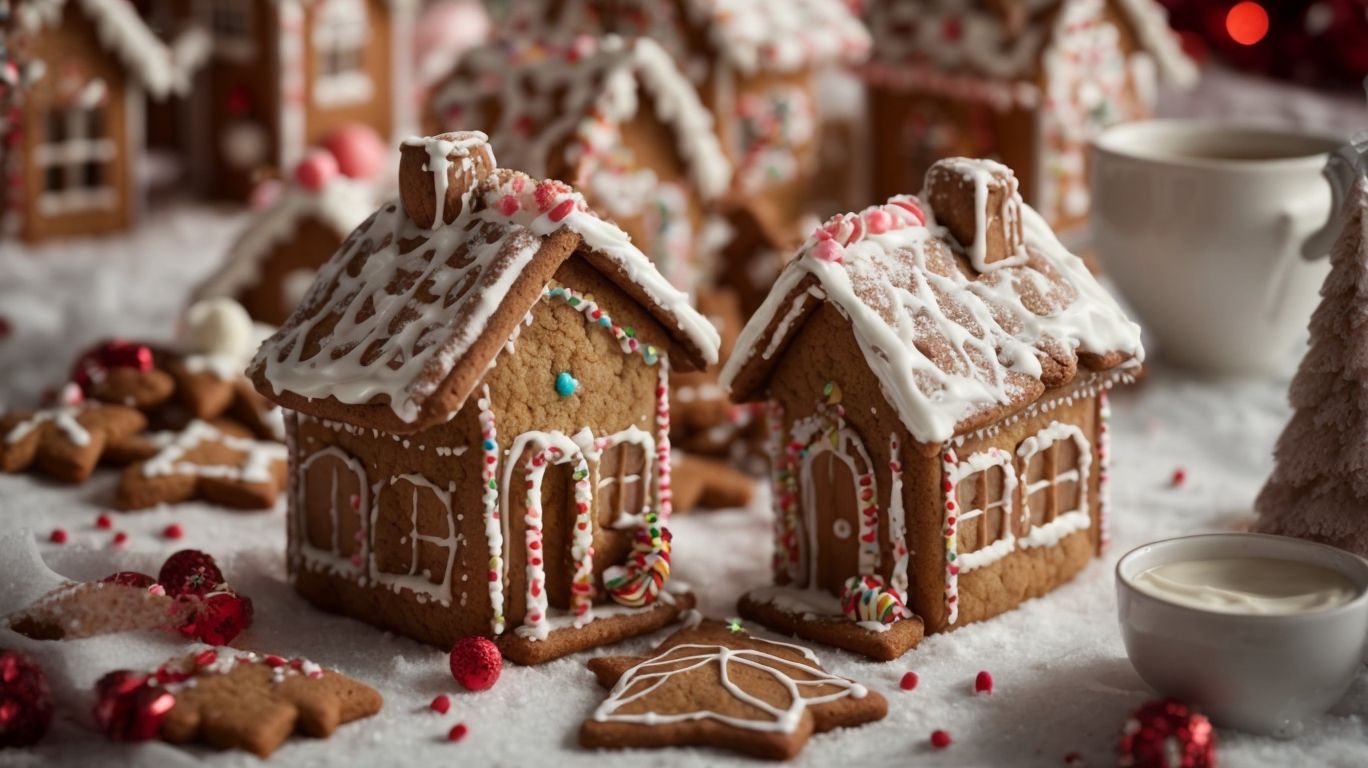How to Bake Gingerbread for a House?
Are you looking to impress your friends and family with a festive and delicious treat this holiday season?
Discover the classic gingerbread house! We’ll guide you through baking and assembling the perfect gingerbread house, from making the gingerbread dough to decorating with royal icing.
Find tips for troubleshooting baking problems and explore alternative ideas for gluten-free, vegan, and miniature gingerbread houses.
Unleash your creativity in the kitchen and get ready to impress!
Key Takeaways:
About Gingerbread Houses
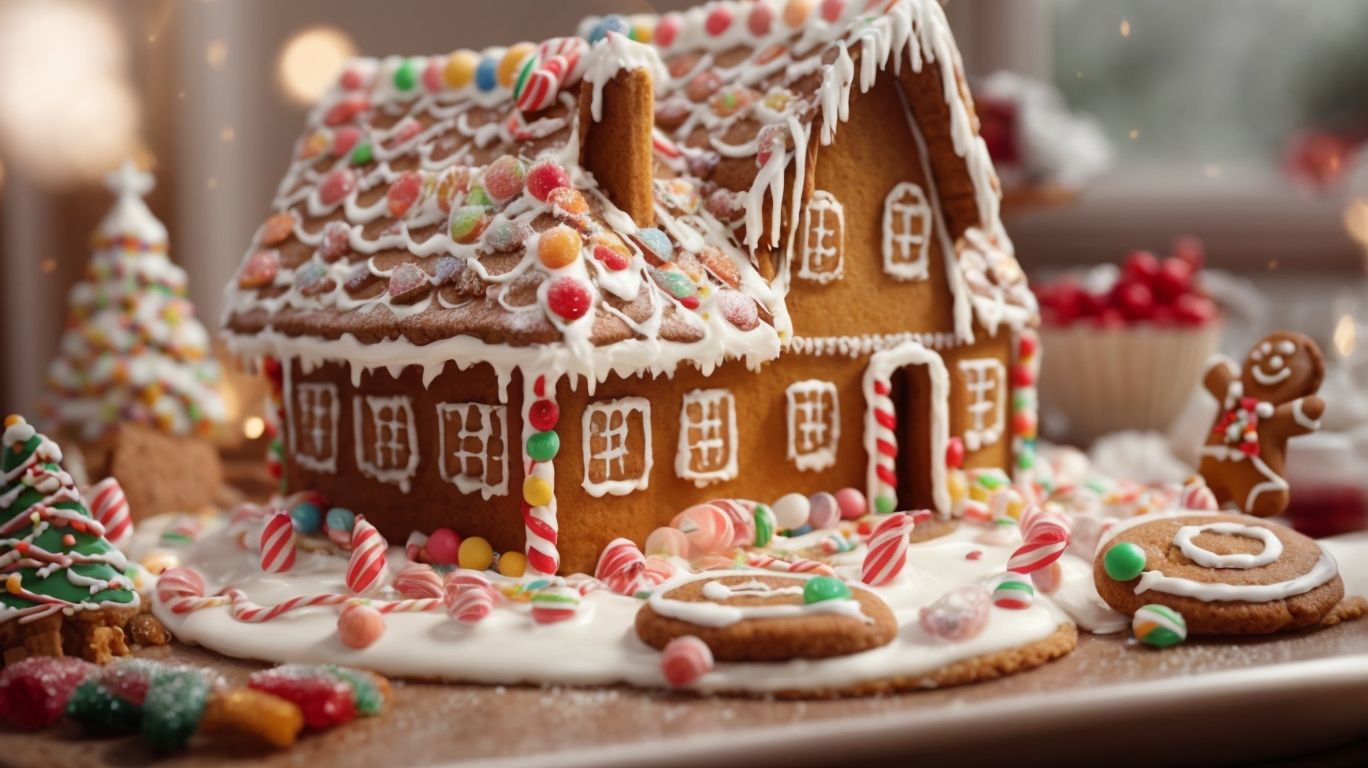
Credits: Poormet.Com – Paul Rodriguez
Gingerbread houses are delightful holiday creations that bring warmth and joy to festive occasions. Crafted from fragrant gingerbread dough, these edible structures are often adorned with colorful candies and royal icing decorations.
The tradition of making gingerbread houses can be traced back to Germany in the 16th century. They were inspired by the fairy tale Hansel and Gretel, where the siblings discover a house made of gingerbread and sweets in the forest. This sparked the idea of creating edible houses as part of holiday celebrations. Over time, gingerbread houses have become a popular activity during the winter season, encouraging families and friends to gather together and showcase their creativity.
What You’ll Need to Bake a Gingerbread House
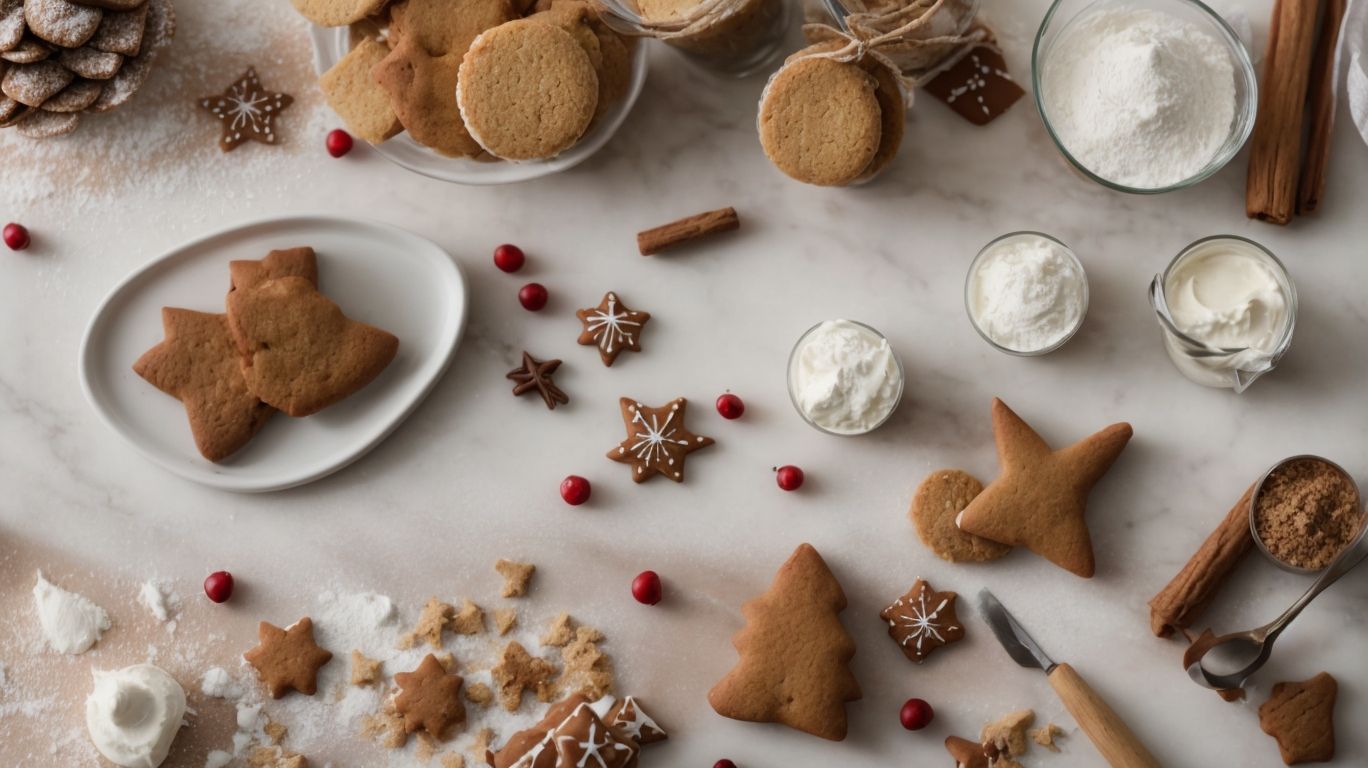
Credits: Poormet.Com – Gregory Taylor
To bake a gingerbread house, you’ll need a variety of ingredients and tools to create the perfect holiday centerpiece. From gingerbread dough to colorful decorations like royal icing and candies, each element plays a crucial role in bringing your gingerbread house to life.
Let’s start with the foundation of your gingerbread house – the gingerbread dough. This dough acts as the building blocks, providing the structure and delicious flavor to your creation. It should be firm enough to hold its shape when baked but still tender to eat. Quality spices such as cinnamon, cloves, and ginger are essential to infuse your dough with that warm, festive aroma.
Now, onto the royal icing, the mortar that holds your gingerbread house together. This stiff, sugary-sweet icing dries to a hard, durable finish, securing your walls and roof in place. Consistency is key when making royal icing; it should be thick enough to pipe but not too stiff that it’s difficult to work with.
Ingredients
The key ingredients for baking a gingerbread house include flour, cinnamon, sugar, molasses, ginger, nutmeg, cloves, salt, vegetable shortening, and eggs. These ingredients combine to create a flavorful, aromatic dough that forms the foundation of the gingerbread house.
Flour, the primary dry ingredient, provides structure and foundation to the dough. Cinnamon adds warmth and a hint of sweetness, enhancing the overall flavor profile. Sugar not only sweetens the dough but also aids in creating a tender texture. Molasses lends a rich, deep flavor with slight bitterness. Ginger, known for its spicy and earthy notes, is key to the distinct taste of gingerbread. Nutmeg and cloves offer warm, aromatic undertones that complement the ginger. Salt balances the sweetness and enhances all flavors. Vegetable shortening contributes to the dough’s texture, ensuring a tender crumb. Eggs bind everything together, providing moisture and structure.
Tools
Essential tools for baking a gingerbread house include a silicone baking mat, gingerbread house pattern template, x-acto knife for precise cuts, sugar windows made from jolly ranchers or isomalt, decorating supplies like Ateco piping tips (352, 32), and other confectionary tools for intricate designs.
These tools play a crucial role in ensuring the success of your gingerbread house project. The silicone baking mat provides a non-stick surface, making it easier to roll out the dough and prevent sticking. A gingerbread house pattern template guides you in cutting the pieces with precision, while the x-acto knife allows for intricate details and clean lines.
Sugar windows made from jolly ranchers or isomalt add a delightful touch to your creation, letting light shine through beautifully. Ateco piping tips, like the 352 and 32, help you create stunning decorations with ease and precision.
Utilize these tools effectively by starting with a well-floured silicone baking mat to roll out your dough and cut out the pieces using the pattern template and x-acto knife. Assemble the house with melted sugar windows and decorate using the Ateco piping tips for intricate details and designs. Remember, the right tools can make all the difference in creating a beautiful and structurally sound gingerbread house.
Step-by-Step Guide to Baking a Gingerbread House
Baking a gingerbread house involves a series of steps, from preparing the gingerbread dough to shaping the pieces, baking them to perfection, assembling the structure, and finally, decorating with royal icing and festive decorations.
Once you’ve mixed and chilled the gingerbread dough, the next step is to roll it out to the desired thickness and cut out the house’s various shapes. Using templates or a ruler to guide you will ensure consistency in size and shape.
After carefully cutting out the walls, roof, and other components, remember to re-chill the dough before baking to prevent excessive spreading. Bake the pieces until they’re firm but not overly browned, as they will continue to harden as they cool.
Assembling the gingerbread house requires patience and precision. Use a sturdy icing, like a mixture of powdered sugar, egg whites, and a touch of cream of tartar, to cement the pieces together.
Once the structure is secure, unleash your creativity in decorating! From candy cane fences to pretzel log piles, the possibilities are endless. Let your imagination run wild as you transform your gingerbread house into a festive masterpiece.
Making the Gingerbread Dough
Creating the perfect gingerbread dough is the foundation of a successful gingerbread house. Combine flour, cinnamon, sugar, molasses, ginger, vegetable shortening, eggs, and other dry ingredients to form a sturdy and flavorful dough.
To start the process, sift together the flour, a key ingredient for structure, and aromatic spices like cinnamon and ginger. These spices, along with molasses, infuse the dough with that distinctive gingerbread flavor. The sugar adds sweetness and helps with browning during baking. Incorporating vegetable shortening or butter enhances the dough’s texture and aids in the construction of your gingerbread house.
When mixing the ingredients, beat the eggs separately to ensure even distribution and then add them slowly to the dry mixture. This step helps bind the dough together and create a smooth consistency. The ratio of ingredients is crucial; too much flour can lead to a dry dough that is difficult to work with, while too little can result in a sticky mess.
Rolling Out the Dough and Cutting Out the Shapes
After preparing the dough, roll it out evenly and use a gingerbread house pattern to cut out the required shapes, such as walls, roof pieces, and other structural elements, using an x-acto knife for precision.
It’s crucial to maintain a consistent thickness throughout the dough to ensure even baking and stability. Templates serve as a guide for cutting precise shapes, creating a streamlined process and enhancing the overall appearance of your gingerbread house. Precision is key when cutting out the pieces as any deviations may lead to misalignment during assembly.
Efficiency is essential to minimize waste, so strategize the placement of templates on the rolled-out dough to maximize the number of pieces cut. Consider re-rolling leftover dough for smaller components, preventing unnecessary disposal. By working systematically and striving for accuracy in each cut, you’ll achieve uniform pieces that fit seamlessly together.
Baking the Gingerbread Pieces
Bake the gingerbread pieces in a preheated oven until they are firm and fragrant, ensuring that the flour, cinnamon, sugar, ginger, nutmeg, and cloves meld together to create a delicious aroma that permeates the kitchen.
To achieve the perfect blend of flavors and textures in your gingerbread, it’s crucial to monitor the oven temperature closely. A temperature of around 350°F (180°C) is ideal for baking gingerbread pieces to ensure they cook evenly and develop that signature rich taste. Keep a watchful eye as they bake, looking for a slightly golden hue that indicates they are ready. This color change signals that the sugars have caramelized, enhancing the sweetness and depth of flavor in each bite.
Assembling the House
Assemble the gingerbread house by using royal icing as mortar to join the walls, roof, and other components together securely.
The key to a successful gingerbread house construction lies in the proper alignment and support of the different parts. Make sure the walls are standing upright, and the roof has the right pitch for stability.
Applying royal icing generously in between the joints will ensure a strong bond, allowing the pieces to set firmly. Reinforcing the corners and edges with extra icing will provide added durability.
Regarding decorative elements, mastering piping techniques is essential. Use different sized piping tips to create various designs on the house, such as snowflakes, candy canes, or even shingles on the roof. Practicing on a separate surface before applying designs to the house can help refine your piping skills.
Decorating the House
Let your creativity shine as you decorate the gingerbread house with festive accents like a chimney, colorful candies, intricate buttercream designs, and royal icing details that add charm and whimsy to your creation.
When constructing the chimney, consider using small pretzel sticks or chocolate bars to mimic a real fireplace structure. Placing an assortment of gumdrops, peppermint swirls, and gum candies around the house can create a vibrant and cheerful exterior design. Delicate buttercream swirls or piped snowflakes offer a touch of elegance, while the intricate royal icing designs can bring a magical touch to your gingerbread masterpiece.
Tips for Baking the Perfect Gingerbread House
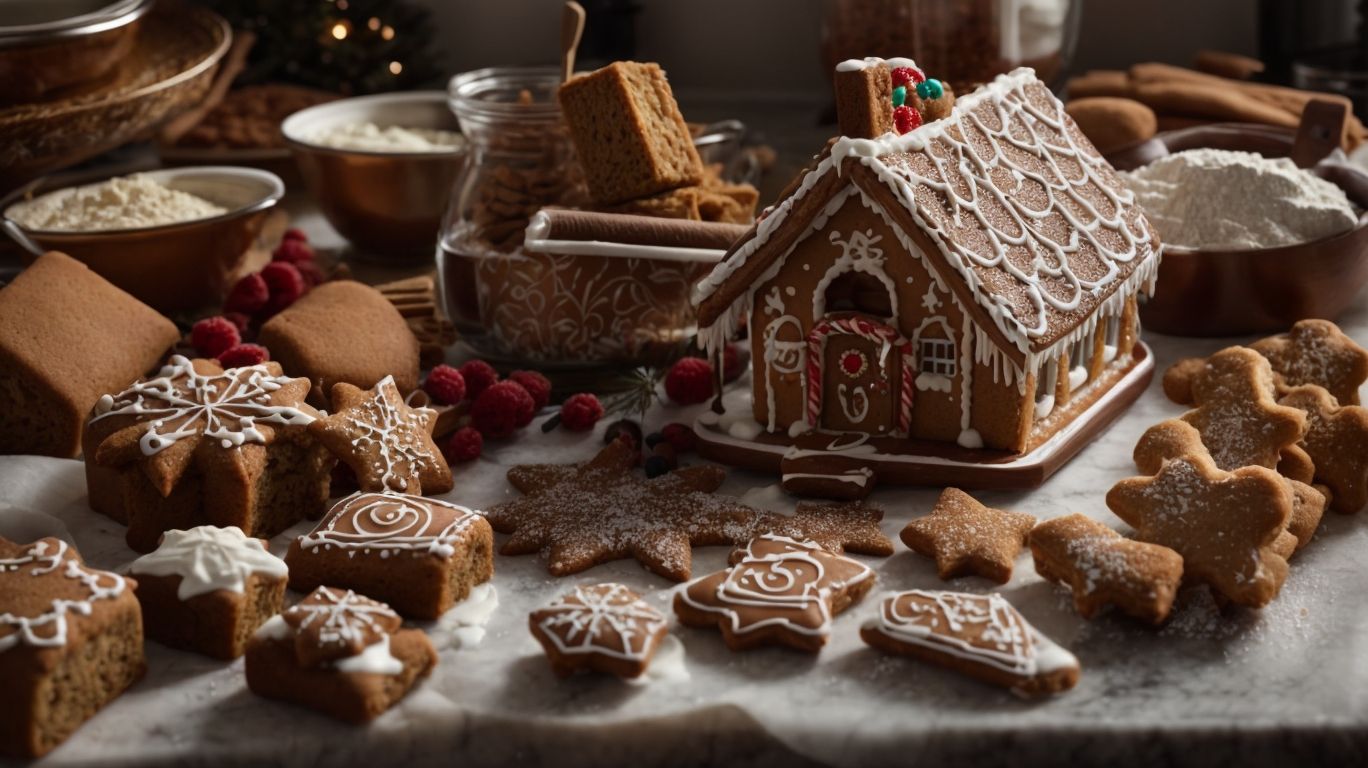
Credits: Poormet.Com – Daniel Carter
Achieving the perfect gingerbread house requires attention to detail and some helpful tips along the way. A sturdy gingerbread recipe, strong royal icing for structural integrity, and creative decorating ideas are key to crafting a flawless creation.
One critical aspect of a successful gingerbread house is the dough itself; you want a sturdy and reliable base that won’t collapse under the weight of decorations. Be sure to chill your dough adequately before rolling it out, as this helps prevent spreading during baking and ensures clean edges for construction. Investing in a good quality royal icing with the right consistency is paramount. This icing acts as the ‘glue’ that holds your house together, so it needs to be thick enough to provide support but not too stiff to pipe. When decorating, consider using a variety of candies, sprinkles, and edible embellishments to add visual interest and personality to your creation.
Use a Sturdy Gingerbread Recipe
Opt for a sturdy gingerbread recipe designed specifically for constructing gingerbread houses, ensuring that the dough can withstand the weight of decorations and provide structural support for the house’s components.
When selecting a gingerbread recipe for your construction project, sturdiness should be a top priority. Look for recipes that incorporate ingredients like molasses, brown sugar, and spices that not only lend a rich flavor but also contribute to the dough’s strength.
It is advisable to use a recipe that includes a higher ratio of flour to prevent the dough from spreading or collapsing during baking. This will help maintain the shape and integrity of your gingerbread structure.
Consider adding a touch of ground ginger or cinnamon to enhance the aroma and provide a festive holiday scent while ensuring the dough’s structural integrity remains intact.
Let the Gingerbread Cool Completely Before Assembling
Allow the baked gingerbread pieces to cool completely before attempting to assemble the house, as warm pieces may deform or collapse under the weight of decorations. Patience in cooling ensures a stable structure.
Once the gingerbread components are out of the oven, resist the temptation to rush into assembly. Place them on a wire rack in a well-ventilated area to cool naturally. Proper cooling is crucial, so avoid speeding up the process in the refrigerator to prevent uneven cooling and warping. For best results, let them cool at room temperature for at least 1-2 hours, allowing the pieces to harden and firm up. This step acts as the foundation for a successful gingerbread structure, ensuring longevity during the decorating process.
Use Royal Icing for Stronger Bonds
Employ royal icing as the primary adhesive for gingerbread house construction, as its firm consistency creates strong bonds between the pieces and acts as a versatile medium for attaching decorations.
When using royal icing, it is important to ensure that the icing is of the right consistency – not too thick, as it can be difficult to spread, nor too runny, as it won’t hold the pieces together effectively. A good tip is to pipe a thin line of icing along the edges of the gingerbread pieces before joining them, allowing it to set for a few minutes to create a secure bond.
For intricate designs or decorations, consider using a piping bag with a small tip to control the flow of icing and achieve precise detailing. Royal icing also dries to a hard finish, providing durability for your gingerbread creation.
Get Creative with the Decorations
Unleash your creativity by exploring unique decoration ideas for your gingerbread house, from intricate designs and patterns to whimsical themes and colorful accents that transform your creation into a work of art.
Get inspired by trying out a variety of decorating styles such as classic holiday motifs, modern minimalist aesthetics, or even fun and quirky themes like candy wonderlands or winter wonderlands.
Experiment with different types of edible decorations, such as fondant, royal icing, gumdrops, and sprinkles, to add texture and dimension to your gingerbread masterpiece.
Consider incorporating handcrafted decorations like miniature wreaths, edible glitter, or even personalized gingerbread people to infuse your house with a one-of-a-kind charm.
Alternative Gingerbread House Ideas
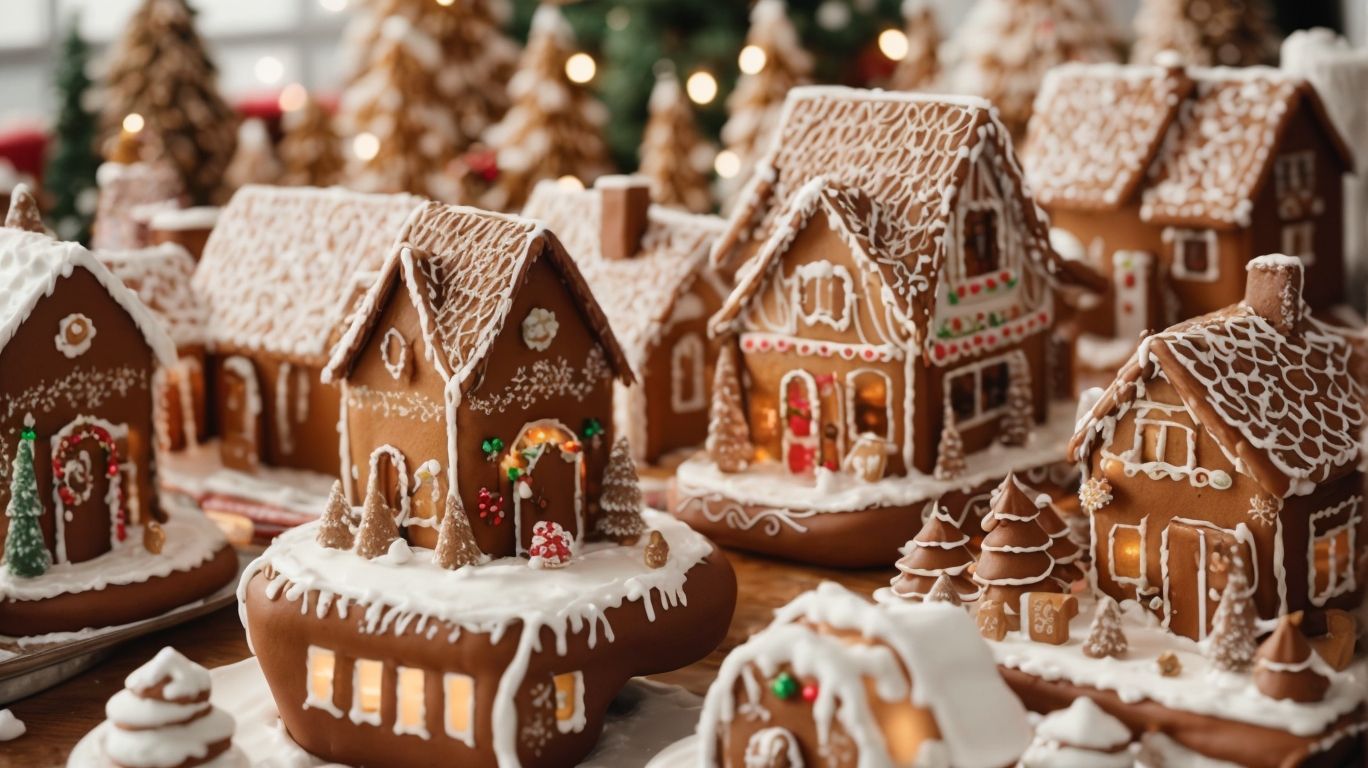
Credits: Poormet.Com – John Wright
Explore alternative gingerbread house ideas beyond the traditional recipe, such as creating gluten-free versions, vegan-friendly options, or miniature gingerbread houses for a whimsical touch.
For those with gluten sensitivities or preferences, swapping traditional flour for almond flour or a gluten-free baking mix can result in a delightful gingerbread house that is safe for everyone to enjoy.
Embracing a plant-based lifestyle? Try substituting eggs with flaxseed meal or applesauce in your gingerbread recipe and using plant-based butter for a vegan-friendly twist. These adaptations not only cater to specific dietary needs but also provide a delicious and inclusive treat for all guests.
Gluten-Free Gingerbread House
Craft a delightful gluten-free gingerbread house using alternative flours and ingredients that cater to gluten-sensitive individuals, ensuring that everyone can enjoy the festive tradition of gingerbread house making.
For the perfect gluten-free gingerbread dough, opt for a blend of gluten-free flour like almond flour, coconut flour, and a bit of arrowroot starch.
When making the dough, make sure to refrigerate it for at least an hour before rolling it out to allow the flavors to meld and the dough to firm up.
To enhance the gingerbread flavor, include a mix of warm spices like cinnamon, cloves, nutmeg, and of course, plenty of ginger.
When assembling the gingerbread house, using a royal icing made with confectioners’ sugar and aquafaba (chickpea liquid) can help achieve the right stability for the structure.
Vegan Gingerbread House
Embrace plant-based ingredients and cruelty-free options to craft a vegan gingerbread house that aligns with ethical and dietary considerations, offering a delicious and inclusive alternative for vegan individuals.
When creating your vegan gingerbread house, consider using ingredients like coconut oil instead of butter and aquafaba as a replacement for egg whites in your royal icing for a fluffy texture. Swap traditional milk with oat milk or almond milk for a creamy sweetness. To enhance the gingerbread flavor, add cinnamon, nutmeg, and cloves for a warm, festive aroma that permeates the entire house as it bakes.
Miniature Gingerbread Houses
Embark on a whimsical journey by creating miniature gingerbread houses that enchant with their tiny details and compact designs, offering a charming and intricate twist on the traditional gingerbread house concept.
When venturing into the world of crafting these delightful miniatures, it’s essential to scale down your designs while still retaining the essence of a classic gingerbread house. Utilize small cookie cutters for creating the house components such as walls, roofs, and even windows. This way, you can ensure that each detail is proportionate to the overall miniature structure.
To add intricate details, consider using a piping bag with a thin nozzle to apply royal icing delicately. This method allows for precision in decorating your miniature house, from creating snow-like icing drizzles on the roof to piping tiny wreaths around the windows.
Working within limited space requires clever organization. Opt for mini candies and sprinkles that fit the scale of your project, and arrange them thoughtfully to avoid overcrowding. Remember, simplicity can often enhance the charm of your miniature creation.
Troubleshooting Common Gingerbread House Baking Problems
Encounter and overcome common challenges in gingerbread house baking, from sticky or dry dough issues to collapsing structures during assembly and difficulties in icing adherence and decoration placement.
One key element to prevent sticky dough is ensuring you chill it sufficiently before rolling out. Remember, the dough consistency should be firm but manageable, not too soft or too hard. If your house often collapses, consider extra support with pretzel sticks or toothpicks while constructing. When facing icing problems, try adjusting the thickness by adding more powdered sugar for a stiffer mixture. For decorations, use a steady hand and royal icing for secure attachment, or opt for edible glue as an alternative method.
Gingerbread Dough Is Too Sticky or Dry
Adjust the moisture content of your gingerbread dough by incorporating additional flour for sticky dough or increasing liquid ingredients for dry dough, ensuring a balanced consistency conducive to shaping and baking.
To remedy sticky gingerbread dough, gradually add small amounts of flour while kneading until the dough becomes smooth and no longer clings excessively to your hands or rolling pin. On the other hand, if your dough is dry and crumbly, drizzle small doses of water or milk at a time, mixing thoroughly until the dough holds together without being too wet. Finding the perfect balance in texture is crucial to prevent gingerbread from spreading too much or becoming tough after baking.
Gingerbread House Collapses During Assembly
Prevent gingerbread house collapses by reinforcing the structure with additional royal icing support, ensuring that each piece is securely attached and stable before proceeding with further assembly or decoration.
One effective way to strengthen the structure is by applying a generous amount of royal icing along the edges of the gingerbread pieces before joining them together. This will create a solid bond and prevent weak spots that might lead to collapses later on.
Make sure to let each section dry completely before adding on the next part. Patience is key in ensuring a stable and sturdy construction. Watch out for any signs of sagging or shifting, and reinforce those areas with extra icing or even small support pieces like pretzel sticks or candy canes.
Remember, a well-built gingerbread house not only looks beautiful but also stands the test of time during the holiday season.
Icing Won’t Stick to the Gingerbread Pieces
Improve icing adhesion by roughening the surface of gingerbread pieces with a gentle scrape or adding a thin layer of icing to create a bonding surface that enhances the adhesion and stability of decorations.
Another effective method to ensure a strong bond between the icing and gingerbread is to let the pieces dry completely before assembling them. This step allows the icing to set firmly, providing a sturdy base for intricate decorations. Consider adding a touch of corn syrup to the icing mix to enhance its stickiness, ensuring that the decorations stay in place securely. You can use a piping bag with a small tip to apply the icing precisely and in fine detail, promoting better adherence and a professional finish.
- For an added decorative touch, sprinkle edible glitter or colored sugar on the wet icing before it dries, creating a sparkling effect that not only enhances the appearance but also helps in the bonding process.
- Maintaining a consistent temperature and humidity level in your workspace is crucial for successful icing adhesion. Extreme temperatures can cause the icing to crack or slide off, leading to poor bonding with the gingerbread. By keeping the environment stable and comfortable, you create optimal conditions for the icing to adhere firmly to the surface, ensuring that your decorations stay put throughout the festive season.
Frequently Asked Questions
1. How do I make gingerbread dough for a house?
To make gingerbread dough for a house, you will need flour, sugar, molasses, spices, butter, and eggs. Mix the dry ingredients together, then add in the wet ingredients and mix until a dough forms. Chill the dough before rolling it out for best results.
2. Can I use a pre-made gingerbread mix for a gingerbread house?
Yes, you can use a pre-made gingerbread mix for a gingerbread house. Simply follow the instructions on the package and be sure to chill the dough before rolling it out for the best results.
3. How thick should the gingerbread dough be for a gingerbread house?
The gingerbread dough for a house should be about 1/4 inch thick. This will provide enough support for the structure of the house while also being thin enough to easily cut and shape.
4. How long should I bake the gingerbread pieces for a gingerbread house?
It is recommended to bake gingerbread pieces for a house for about 10-12 minutes at 350°F. Be sure to keep an eye on them and take them out when they are lightly golden brown.
5. Can I use royal icing to decorate my gingerbread house?
Yes, royal icing is the best type of icing to use for decorating a gingerbread house. It dries hard and provides a strong bond for the pieces of the house.
6. How can I make my gingerbread house stay together and not collapse?
To ensure your gingerbread house stays together, make sure the pieces are properly cooled and hardened before assembling. Use royal icing as a strong glue and let the gingerbread pieces dry for at least 30 minutes before adding any decorations or adding another piece to the structure.

